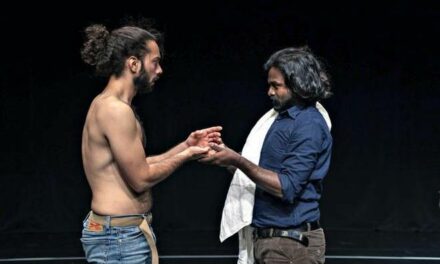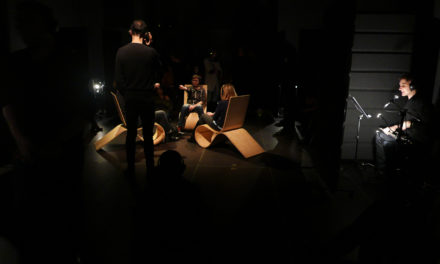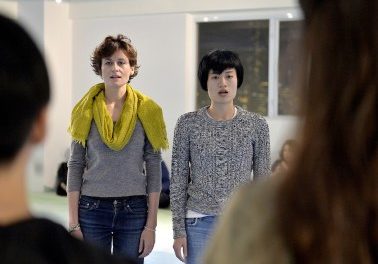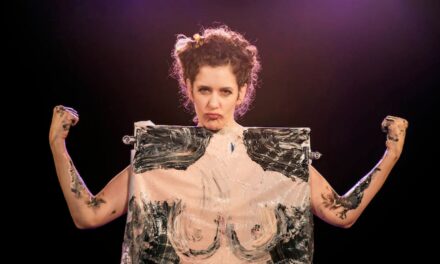“Comrades,” said the woman in a loose zebra print dress and bright red lipstick, “this is not a performance. This is our Golden Triga.” She was part of the team behind “This building truly talks,” an installation representing the Republic of North Macedonia, which won last night’s top honor at the 2019 Prague Quadrennial awards ceremony. The professional and personal value the prize holds for her was evidence in her voice, full of joy and the gratitude of being recognized in a community of esteemed peers. “This building truly talks” is an ongoing, collaborative, performative experience inspired by the society that exists within the Residential Railway Building in Skopje, and the artists dedicated their win to the residents who have opened their doors, literally and figuratively, to collaboration. The version in Prague, an archive one-hundredth the size of the full piece, was recognized at the awards as:
“a multilayered collaborative work that brings together many forms of scenography: space, stage, exposition, memory, community and communication. It demonstrates how performance activates an exhibition space, how design instigates narrative and scenography becomes activism within and beyond political context.”
Every other winner reflected one or more of those values.

Winner of the Golden Triga,
“This Building Truly Talks” from the Republic of North Macedonia. Photo by Adéla Vosičková.
The collaboration was the primary ethos of the evening. One after another, winners thanked their colleagues who were there in Prague, or back home, in the theatres and workshops which produced the winning entries. The award ceremony itself was collaborative, as the hosting duties were shared by actresses Ester Geislerová and Johana Ožvald. They wore matching over-sized tulle gowns and hats, like something out of “Taboo Collection,” but Ožvald was playing a robot-host sent to the festival from the Ministry of Defense and Culture. Czech theater is, after all, the source of the word robot (it was coined by Josef Čapek for his brother Karl’s play R.U.R.) so this high-tech gag was well in keeping with tradition.
Other bits from the festival organizers showed the spirit of collaboration too. The nine-person jury consisted this year of Dorita Hannah, Tim Foster, Jim Clayburgh, Liu Xinglin, Sofia Pantouvaki, Robert Kaplowitz, Yaron Abulafia, Sodja Lotker, Omar Rajeh, Monica Raya and Kate Bailey. Throughout the evening, the PQ’s three artistic directors presented awards as a group. There were also a series of funny videos that punctuated the ceremony. Some were cheeky “Fundamentals of scenography” clips (a costume designer whose work precludes the possibility of going to the bathrooms), invitations to come “learn the fundamentals” at the PQ. These are the same kinds of videos that run as ads for Prague cinemas before the feature – quirky, self-deprecating, yet with high production values.
The greatest distillation of the identity of the PQ came in a series of video tutorials addressing the question “What can you do with a PQ award?” The statuette itself is in three running horses red, black and clear stacked on top of each other and connected with a horseshoe underneath. (I saw one up close when the person sitting next to me went up to claim an award on behalf of her boss.) The video demonstrated using the award as a plate for canapés, ping pong paddles, and mallets to pound out schnitzel. In a million years you couldn’t imagine the Tonys, which were also given out this week, taking themselves so lightly.
The winners were refreshingly diverse, a real reflection of the international spirit of the festival. No single country or region dominated and in fact, very few pieces won more than one award. This is the polar opposite of what I’ve experienced growing up in the United States, raised on an awards system where certain wins predict certain others, and year after year, #OscarsSoWhite. Only Mexico won more than two awards, and the third was major: the dancing fox of La Liga Teatro Elástico won an Award for Excellence in Performance Design, or as the spokesman said, “all the nonsense that we make in the workshop”, as did costume designer Jerildy Bosh, and Natalia Sedano won the Award for Most Promising Talent. Que viva Mexico!

Part of the students’ exhibition from Georgia. Photo by Alžbeta Jungrová.
The most ecstatic award winners were the students, rightly so. The crowds cheered for them, and some of the “adult” artists also thanked the students from their country with whom they had collaborated. The students’ pavilion, though less high tech than what you see in the main exhibition hall, pulsates with originality and potential. Students from Taiwan, Finland and the Republic of Georgia each took an award for Best Student Exhibition Experience. The team from Taiwan, whose project “The Changing Room” allows you to inhabit a new persona by picking an outfit from their wardrobe, looked cool coordinated in black, white and olive green.
Student teams from Italy, Czech Republic, and the Philippines were all honored with a Students’ Imagination Award. Only the students showed their excitement corporeally, hugging, dancing, and one cheeky Italian even stole a kiss from Geislerová. They deserve it. As the director of my grade-school theatre used to say, reducing my mom to tears every time, “The kids worked so hard on this show.”

Students from the Czech Republic won for their travel agency, Prague Isn’t Czech. Photo by Adéla Vosičková.
Most people didn’t have a thank-you speech prepared. One of the few who did was Zhou Zhengping, a lighting designer from China who won for Excellence in Performance Design, was the only person who opted not to speak in English. With the help of his interpreter, he explained the importance of the PQ in Chinese theatre culture. Since 1987, Chinese artists have been traveling to Prague to join the international community in a gesture of openness and cooperation. His award, I felt, is an important chapter in that still-developing history.
Not everyone who won was there; often they shared their messages of thanks via text messages to colleagues. The woman sitting next to me who claimed a prize from the stage did so on behalf of Kirsten Dehlholm, the Danish winner of the Lifetime Achievement Award. Arnold Aronson, a theatre professor at Columbia University in New York was unable to attend the festival because of illness, but he won this year’s Mentor Award, a prize which usually goes to practicing artists rather than instructors. The American education system notoriously undervalues the humanities, so it was heartening to see this award go to a teacher, and I hope that the news buoys his spirits. The most touching moment of surrogacy was when a diplomat accepted an award for Excellence in Performance Design on behalf of Ivan Marušić Klif from Croatia. She said, “I’m not having his message on the mobile, but believe me, he is waiting in Croatia with his mobile, so I have to hurry and tell him that he won.”
It was a great event – casual, fun and full of more emotion than ego. Now, a confession. 48 hours before the award ceremony, I didn’t know that there would be one. But as soon as the lights dimmed, I pictured myself winning, as I have every year on Oscar Night since early childhood. “And the award for Excellence in Media Coverage goes to…Abigail Weil!” There was no award for Excellence in Media Coverage and if there were, it wouldn’t go to the first-time squirt like me who can’t even figure out the ticket reservation system. But I do know who I would thank – my boss and mentor here at The Theatre Times, Magda Romanska, tireless educator and champion of accessibility in the arts. Magda, maybe we’ll get our moment in another four years.
This post was written by the author in their personal capacity.The opinions expressed in this article are the author’s own and do not reflect the view of The Theatre Times, their staff or collaborators.
This post was written by Abigail Weil.
The views expressed here belong to the author and do not necessarily reflect our views and opinions.


















